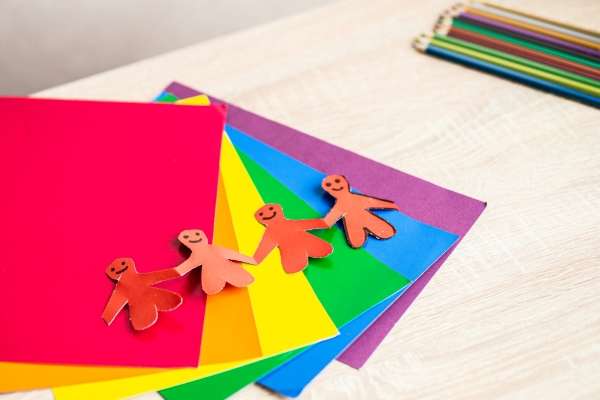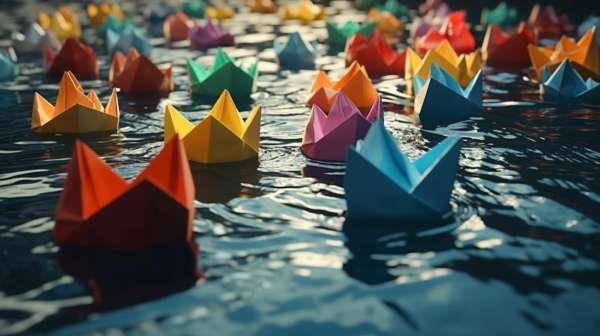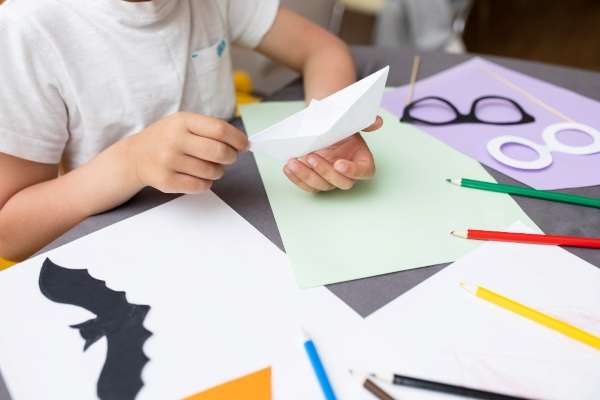Origami, derived from the Japanese words “oru” (to fold) and “kami” (paper), is the traditional art of paper folding. Without using scissors or glue, this art transforms a flat square piece of paper into a finished sculpture. Now, imagine introducing your little one to the captivating realm of origami. Simple origami for preschoolers is not just an introduction to paper folding; it’s a gateway to boundless imagination. You see, origami is a magical craft. With just a piece of paper, hands get busy, and before you know it, a flat piece blossoms into a 3D masterpiece.
Let’s paint a picture. It’s a rainy day, and your child is restless. You grab a colorful square of paper and start folding. In moments, you’ve crafted a little boat. Your child’s eyes light up, and soon, they’re sailing their boat on the puddle outside. Next, you fold a soaring bird, and their imagination takes flight.
This isn’t just about creating shapes, though. Simple origami for preschoolers is a building block. It lays the foundation for patience, precision, and a keen sense of detail. And most importantly, it teaches them that with a little creativity, the sky’s the limit.

Materials Needed
- Square origami paper (preferably in different colors)
- A flat surface, like a table or desk
- Patience and a smile!
Safety Precautions
- Ensure the workspace is free from sharp objects or distractions.
- Use child-friendly and non-toxic materials.
- Always supervise children during crafting time.
The Origins of Origami
In ancient Japan, a place where traditions run deep and artistry is a way of life. Origami wasn’t just a pastime; it was a heartfelt expression. For generations, the delicate art of folding paper was passed down, with each fold representing a piece of history and culture.
Now, think about the vibrant festivals in Japan. The streets filled with colorful origami birds, representing wishes for good health and happiness. Or the tradition of gifting tiny paper cranes to someone ill, with hopes of a speedy recovery. These weren’t just paper figures; they held meaning and sentiment.
Simple origami for preschoolers today is a glimpse into this rich past. It’s not just about making a cute animal or a fun toy. It’s a way to connect with a tradition that’s centuries old. Every time your little one folds a paper, they’re participating in a timeless art form, touching a part of history, and weaving their own story into its vast tapestry. So, the next time you and your preschooler sit down with a square paper, remember: you’re not just folding, you’re journeying through time.
Paper Selection and Preparation for simple origami for preschoolers
- Choose papers that are easy to fold. For starters, lightweight origami paper is best.
- Ensure the paper is a perfect square. If not, ask an adult to help you trim it.
Basic Folding Techniques
1. Valley Fold:
- Lay the paper flat.
- Pick an edge and fold it to meet the opposite edge.
- Press down to make a crease. Now you have a valley!
2. Mountain Fold:
- Lay the paper flat.
- Take two opposite corners and fold them together.
- Press down for a crease. It looks like a mountain peak!
Remember, practice makes perfect. Try these folds a few times.
Simple origami for preschoolers: Easy projects

1. Origami Boat:
- Start with a square piece of paper.
- Fold it in half horizontally. Unfold.
- Fold both the top and bottom edges to the center crease.
- Fold the corners in, forming triangles.
- Fold the top and bottom edges inwards.
- Finally, open up the paper from the bottom and flatten it to form a boat shape!
2. Origami Hat:
- Start with a square paper.
- Fold the paper in half, top to bottom.
- Fold the bottom edge up, about an inch or so.
- Now, flip the paper and fold the other edge up too.
- Open it gently and wear your new hat!
3. Origami Dog Face:
- Begin with your square paper, colored side down.
- Fold it diagonally, corner to corner, forming a triangle.
- Take the top corner of the triangle and fold it downwards.
- Fold the left and right corners inwards to form the ears.
- Turn it around and draw a cute face!
Interactive Origami Games

Let’s take these origami creations off the table and into a world of play! Here’s how:
- Origami Boat Races: After crafting little origami boats, it’s race time! Fill up a tub or a shallow basin with water. Using straws, you and the kids can blow on the sails to propel the boats forward.
- Animal Adventures: Gather all the origami animals you’ve made. Now, create a story around them. Maybe the crane and the frog are best friends on a quest to find a lost treasure, or the lion is hosting a big jungle party. Let your child’s imagination run wild, and you’ll be amazed at the tales they weave.
- Flying Contests: Made origami birds or planes? See whose can fly the farthest or highest. It’s a great way to understand aerodynamics in a fun, hands-on manner.
- Origami Theatre: Convert a cardboard box into a little stage. Using origami figures as characters, put on a mini-play.
- Guess the Shape: For a fun guessing game, one person makes an origami creation secretly, and the others have to guess what it is just by feeling or asking yes/no questions.
Tips for Teaching Simple origami for preschoolers
Stepping into the world of origami with little ones can be a joy-filled experience. With the right approach, you can turn it into a memorable bonding time.
Firstly, keep it simple. Kids love clear directions. Instead of using jargon, use easy words. For instance, instead of saying “horizontal fold”, you can say “fold the paper sideways.”
Then, always show them how. Kids are great at copying what they see. So, fold a paper alongside them. They’ll likely follow your lead and mimic your moves.
The beauty of “simple origami for preschoolers” is in the moments of celebration. When they manage a fold or create a shape, celebrate it. A little praise, like “Great job!” or “Look what you made!”, boosts their confidence.
And remember, mistakes are part of the process. If something doesn’t work out, that’s alright. Smile, encourage them to try again, and enjoy the process. Origami is as much about the joy of creation as it is about the final product.
Importance of simple origami for preschoolers

Ever thought about why playing with blocks or coloring within the lines is good for kids? It’s the same with origami. It’s not just about folding paper; there’s a bigger picture. When a child folds paper, they’re learning in so many sneaky ways.
For starters, they get to practice their focus. It’s like a mini workout for the brain. Think about it. Those little hands moving, eyes watching every crease, and the brain figuring out the next step. It’s all about concentration.
Now, here’s the fun part. Simple origami for preschoolers isn’t just arts and crafts time. It’s a quiet math lesson and a sneak peek into different worlds and traditions. Like when they fold a crane, they’re not only creating art but also touching a piece of Japanese culture. Or when they make a paper star, they’re learning about shapes and symmetry without even realizing it.
FAQs
1. Why is origami beneficial for preschoolers?
Origami is not just an art form but a hands-on learning experience. It helps enhance hand-eye coordination, fine motor skills, spatial reasoning, and concentration. Plus, it’s a fun way to introduce kids to cultures and traditions from around the world.
2. Is origami safe for young children?
Yes, origami is generally safe as it primarily involves folding paper. However, supervision is always recommended, especially if younger kids are using scissors or other tools.
3. My child gets frustrated when the origami doesn’t turn out right. What should I do?
It’s natural for children (and even adults) to feel a bit frustrated when starting out. Encourage them to be patient and practice. Let them know that every fold and crease, even the imperfect ones, are part of the learning journey. It might also help to start with simpler models before progressing to more complex ones.
4. Can I use any paper for origami?
While you can technically use any paper, it’s recommended to use lightweight origami paper, especially for beginners. This paper is easier to fold and comes in a variety of colors, making the crafting process more enjoyable for kids.
5. How can I make origami more engaging for my child?
Make it a storytelling session! For instance, if you’re folding an animal, weave a story around it. Use colorful papers, add googly eyes, or even combine origami with other art forms like drawing or painting.
6. Where can we learn more advanced origami as my child’s skills progress?
There are numerous origami books available, both for beginners and advanced crafters. Additionally, there are online tutorials, workshops, and even origami clubs that can help nurture this passion further.
Conclusion
Let’s wrap things up. Think of origami as a treasure chest. Inside, there’s a world full of wonders just waiting to be discovered. Each piece of paper is like an uncharted map, and every fold is a step towards revealing the hidden gems within.
Now, remember those afternoon sessions of simple origami for preschoolers? It’s not just about having a good time. It’s much more than that. With each little paper frog or boat, they’re not only crafting figures but also weaving tales of their own. They learn, they laugh, they sometimes even fumble, but every time they pick that paper up again, they grow.
In the grand scheme of things, it’s about more than paper art. It’s about nurturing a curious mind, creating lasting memories, and setting the stage for a future filled with creativity and discovery. So, here’s to the magic of origami and the little hands that bring them to life. Cheers to adventures in paper and the joys they unfold!





